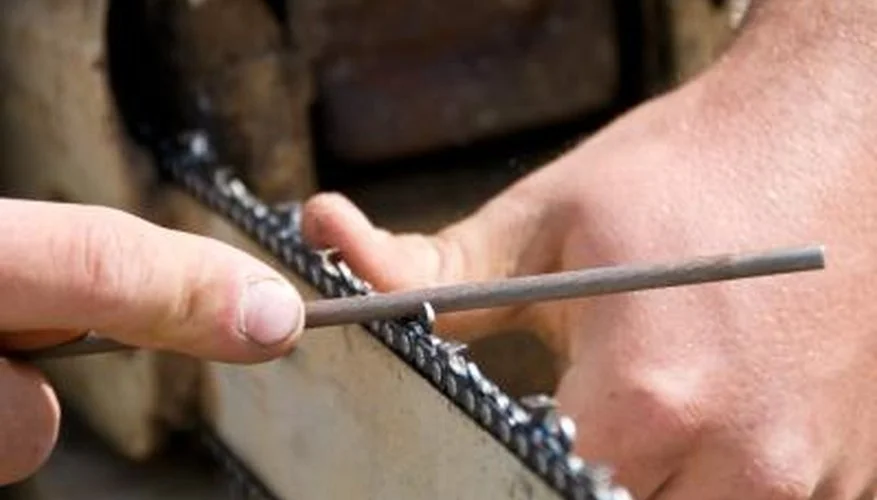Are you new to chainsaw maintenance and wondering what size chainsaw file to use? Choosing the right size file is crucial to keep your chainsaw in tip-top condition and ensure optimal performance.
We will guide about chainsaw files, including their types, sizes, and how to choose the right one for your chainsaw.
Why do you need to use chainsaw files?
Over time, the chainsaw chain will dull due to use, and this can cause it to become less effective and even dangerous. Using a chainsaw file helps to sharpen the chain’s teeth, allowing it to cut through wood easily and quickly. A sharp chainsaw chain will also reduce the risk of kickbacks and improve the chainsaw’s overall performance.
Types of Chainsaw Files
There are two main types of chainsaw files: round files and flat files. Each has a specific purpose and is suited for different chainsaw types.
Round files
Round files are the most commonly used type of chainsaw file. They are cylindrical in shape and come in various diameters. Round files are used to sharpen the cutting edges of the chainsaw’s teeth.
Flat files
Flat files have a rectangular shape and are used for two purposes. They can be used to file down the depth gauge or raker teeth to ensure they are level with the cutting teeth. Flat files can also be used to file the top plate angle of the cutting teeth.

Chainsaw File Sizes
Choosing the right size chainsaw file is crucial to ensure optimal sharpening. The file size you need depends on the chainsaw’s pitch and gauge.
Measuring chain pitch
Chain pitch refers to the distance between three consecutive rivets divided by two. To measure the pitch, use a caliper or ruler and measure the distance between the centers of any three rivets. Then, divide this measurement by two.
Selecting the right file diameter
Once you’ve determined the pitch, you can select the right file diameter. Most chainsaw file manufacturers provide a chart that helps you select the right file diameter based on the chain pitch.
How to Use a Chainsaw File
Filing a chainsaw chain is a simple process. Here are the basic steps to follow:
Preparing the chainsaw
Before you begin filing, ensure that the chainsaw is turned off and that the chain brake is engaged. Remove any dirt or debris from the chain and use a file guide to hold the file in place.
Filing the chain
Use a round or flat file to sharpen the cutting teeth or depth gauge, depending on your chainsaw’s needs. File in one direction, applying consistent pressure and keeping the file perpendicular to the chain.
Checking the file angle
It’s crucial to maintain the correct file angle when sharpening the chain. The file angle is the angle between the top plate and the side plate of the cutting tooth. Most chainsaw manufacturers provide a recommended file angle, which you can use as a guide.
Tips for Successful Chainsaw Filing
Here are a few tips:
- Use a file guide to hold the file in place and ensure consistent filing.
- Keep the file perpendicular to the chain and apply consistent pressure.
- Use the recommended file diameter and angle for your chainsaw.
- File every other tooth to maintain the chain’s balance.
- File all teeth to the same length and angle for consistent cutting.
Common Chainsaw File Problems and How to Fix Them
While filing a chainsaw chain is a straightforward process, there are a few common problems that can arise. Here are most common problems:
- Uneven filing: Ensure that you file each tooth to the same length and angle for consistent cutting.
- Dull or damaged files: Replace the file regularly to ensure optimal sharpening.
- Incorrect file diameter: Use the manufacturer’s recommended file diameter for your chainsaw.
- Incorrect file angle: Use the manufacturer’s recommended file angle for your chainsaw.
- Over-filing: Avoid over-filing, which can cause the chain to become too sharp and increase the risk of kickbacks.
Chainsaw File Maintenance and Storage
To keep your chainsaw files in top condition, it’s important to maintain and store them correctly. Here are a few tips to follow:
- Clean the file after each use to remove any debris or resin.
- Store the file in a dry and secure place.
- Use a file case or pouch to protect the file from damage.
Conclusion
Choosing the right size chainsaw file is crucial to ensure optimal sharpening and performance. By following the guidelines outlined in this guide, you can select the right file size for your chainsaw and sharpen the chain effectively. Remember to maintain and store your chainsaw files correctly to ensure they remain in top condition.
FAQs
You should file your chainsaw chain whenever it becomes dull or damaged, or after every 5-10 hours of use.
Yes, using a file guide can help ensure consistent filing and optimal sharpening.
No, depth gauges should be filed with a flat file.
A dull chainsaw chain will produce sawdust instead of wood chips, take longer to cut through wood, and produce a rough or uneven cut.
Chainsaw files typically last for several sharpenings, depending on how often they are used and how well they are maintained.